Introduction: Unveiling the Connection Between Wood and Tone
Electric guitars are marvels of musical engineering. Unlike their acoustic cousins, they rely on pickups and amplifiers to project sound — but the material they’re made from still plays a pivotal role in shaping tone. Among the many debates in the guitar world, few are as polarizing as the impact of wood, or “tonewood,” on electric guitar sound.
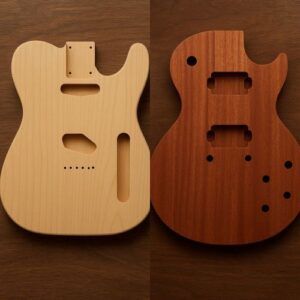
Is it science or snake oil? While some guitarists swear by the warm, rich resonance of mahogany or the bright, punchy tone of alder, others insist the pickups and electronics do all the heavy lifting. Let’s dive into the science, tradition, and player experiences behind the effects of different wood types on electric guitar tone.
** Here’s a little transparency: Our website contains affiliate links. This means if you click and make a purchase, we may receive a small commission. Don’t worry, there’s no extra cost to you. It’s a simple way you can support our mission to bring you quality content.**
As an Amazon Associate, I earn from qualifying purchases.
Overview of Electric Guitars and Their Components
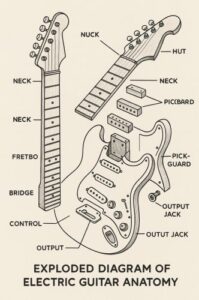
At a glance, most electric guitars follow a similar recipe: a body, a neck (usually glued or bolted on), a fretboard, hardware, pickups, and electronics. Despite this shared foundation, subtle material changes — especially wood choice — can shape everything from sustain to how a note blooms after it’s picked.
Historically, luthiers and builders have carefully selected woods not just for aesthetics or weight, but for tonal properties. The term “tonewood” was born out of this tradition, used to describe woods with sonic qualities that complement a guitar’s design and purpose.
The Anatomy of Tone: How Wood Influences Guitar Sound

Even though electric guitars rely on pickups to convert string vibrations into signal, the wood still contributes to how those vibrations behave. When a string vibrates, it transfers energy through the bridge into the body, neck, and headstock. The resonance and damping characteristics of the wood influence how long the string sustains and how frequencies are emphasized or absorbed.
- The body acts as a resonance chamber, albeit less dramatically than in an acoustic guitar.
- The neck, especially in set-neck or through-body designs, has a big influence on sustain and attack.
- The fretboard wood can subtly affect feel and brightness.
So, while the signal might be electrical, its origin is physical — and wood is part of that physical equation.
Does Wood Type Affect Electric Guitar Tone?

Research Findings
Scientific studies on tonewood’s effect in electrics yield mixed results. Controlled experiments often suggest that pickups and electronics dominate tone, but blind tests and player feedback often identify subtle differences between woods. So, who’s right?
The answer seems to lie somewhere in the middle. Wood doesn’t drastically reshape tone like a pickup swap might, but it subtly colors the vibration profile before it even hits the magnets.
Comparing Common Tonewoods: Their Tonal Fingerprints
Each wood species leaves its own subtle “fingerprint” on electric guitar tone. While not as dramatic as swapping pickups, these tonal traits are why certain woods keep showing up in classic designs:
-
Alder → Balanced and full-bodied with slightly scooped mids. Notes ring clear without harsh highs. Perfect for crisp, articulate playing across multiple genres.
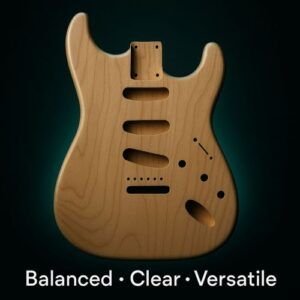
-
Ash → Bright and snappy with strong upper mids and airy lows. Swamp ash leans more open and resonant, while hard ash is denser and punchier. A favorite for spanky, twangy styles.

-
Mahogany → Warm, rich, and resonant with a natural thickness. Enhances sustain and emphasizes low-mids, making it ideal for fat, creamy rock and jazz tones.

-
Maple → Hard and reflective, bringing a fast attack and brightness. Often used as a cap to sharpen darker woods, adding articulation and clarity.

-
Basswood → Soft and neutral, absorbing some high-end harshness. Produces a smooth, even tone that lets pickups define the character. Popular for modern, high-gain styles.

If you’re more interested in how these woods affect weight, workability, and finishing options when building an electric guitar kit, check out my guide on Guitar Kit Wood Choices.
Addressing Skepticism:

Skeptics argue that once a signal is electrified, wood becomes irrelevant. However, blind tests and anecdotal evidence from pro luthiers tell a different story. The resonance and feel of a guitar — how it responds to touch and technique — often align with the chosen wood, even if subtle.
Seeking the Best Tonewood for Your Sound

When chasing tone, there isn’t a single “best” wood — it depends on the style and feel you’re after. Each type emphasizes certain frequencies and playing characteristics:
-
For Bright, Articulate Tones (funk, surf, country):
Alder and maple shine here, delivering clarity, fast response, and note definition. -
For Warm, Heavy Tones (rock, metal, jazz):
Mahogany emphasizes low-mids and sustain, while basswood smooths out the top end for a thick, controlled sound. -
For Balanced Versatility (players who cross genres):
Ash offers both resonance and brightness, making it a flexible choice for those who want one guitar that covers multiple tonal bases.
Tonewood isn’t about better or worse — it’s about matching the wood’s natural voice with the music you want to play.
Want to take your build even further? Check out Customizing Your Electric Guitar Kit With Unique Fretboard Inlays to blend tone and artistry.
Advice From Luthiers and Players
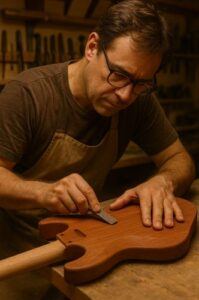
Experienced builders often recommend matching tonewood with the right pickups. For instance, pairing a warm mahogany body with bright single coils can yield a balanced tone. Meanwhile, a maple cap on a mahogany body adds articulation—seen famously in many Les Pauls.
Beyond Wood: Factors That Shape Electric Guitar Sound
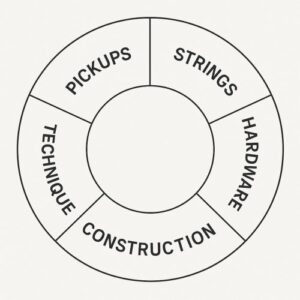
While wood matters, it’s only one part of a much bigger equation. Consider these other tone-shaping elements:
Pickups
The biggest driver of tone. The choice between humbuckers and single coils has a dramatic effect. If you’re undecided, start with our guide: Understanding Humbucker Vs Single Coil Pickups In Kits.
Strings & Hardware
String gauge, bridge design, and nut material all influence sustain and tone. Learn more about the latter in How To Choose The Perfect Nut Material For Your Electric Guitar.
Player Technique
Tone is also in your hands. The way you pick, fret, and mute shapes the final sound more than any spec sheet.
Construction Methods
Set-necks typically offer better sustain, while bolt-ons provide snappier response. Weight relief chambers and top woods also change how a guitar resonates.
Future Trends
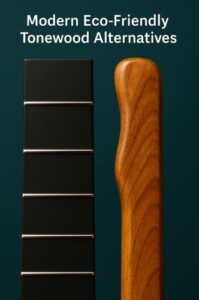
Eco-conscious alternatives like Richlite and roasted woods are gaining ground. These materials offer consistency and sustainability, while still delivering impressive tonal characteristics.
*** Conclusion…

Wood may not be the loudest voice in the electric guitar’s tone choir, but it’s far from silent. Whether you’re chasing vintage warmth or modern clarity, the effects of different wood types on electric guitar tone should not be overlooked. They shape how the guitar feels, resonates, and ultimately, how you connect with it.
Ready to experiment with tone? Start with the right kit, the right wood, and explore how each choice shapes your sound.
- Best Pickups For Your Electric Guitar Kit: Choosing The Right Tone
- How Pickup Position Affects Electric Guitar Tone In Kits
- Using Tone Pots And Capacitors To Sculpt Your Sound
Tone is personal — so build, experiment, and find your voice.
There are 100’s of ways you can build a business around your passion for guitar building.
Check it out…




Very interesting article for me, Wayne, because I like to play a little electric guitar myself. I have always wondered what are the different effects each particular type of wood for an electric guitar that exist. I believe wood density and even the wood’s grain structure play a significant role in the resonance of an electric guitar. A strong and durable wood, such as maple, is ideal for an electric guitar. Thank you for a very educational article, Wayne.
Best wishes,
Kent
Thanks so much for the kind words, Kent! You’re absolutely right, wood density and grain structure both play a big role in how an electric guitar resonates, even with all the electronics involved. Maple’s a great example, bright, strong, and super stable, which makes it a favorite for necks and tops. I’m glad the article gave you some insight into how those wood choices shape tone. Appreciate you stopping by and sharing your thoughts!
This article does a fantastic job of navigating the long-standing debate around tonewoods and electric guitar tone. I appreciate how it acknowledges that pickups and electronics often dominate tone, yet still highlights how woods subtly influence resonance, sustain, and the instrument’s feel. The tonal breakdown—alder for balanced mids, ash for brightness, mahogany for warmth, maple for snappy attack, and basswood for neutrality—is practical and reflective of classic guitar traditions.
I especially like how you emphasize pairing woods and pickups intelligently—like bright single-coils with a warm mahogany body—to create tonal harmony rather than competition. The role of wood isn’t about radical shifts in sound, but nuanced coloring that resonates both physically and emotionally with the player.
Well done blending technical insight with musical intuition. It strikes a perfect chord for builders and players alike.
Thank you so much! I’m glad the guide resonated with you. You’re spot on! While pickups and electronics often shape the core tone, the choice of wood adds those subtle layers of resonance, sustain, and feel that really connect a player to their instrument.
I’m especially happy to hear that the tonal pairings came through clearly. It’s all about creating harmony between wood and electronics so the guitar not only sounds great but feels right in the hands. Those little nuances are what make each build unique and rewarding.
I really appreciate your thoughtful feedback, and I hope it inspires builders to experiment and find their own perfect combinations!
Thanks again,
~Wayne
I love the way you have broken down the different types of wood that the guitar is made from and the difference in sound types. Everyone has their own preference, depending on the type of music genre they prefer to play, so it is good to have this comparison chart.
I love the pic of the guitar made with a mash of different woods and I think this is the most beautiful guitar that I have ever seen.
They say maple is a very strong wood. Would this perhaps be a better bet for someone who plays in a rock band, as it should last longer with all the bouncing around?
Thanks so much for the kind words! I’m glad the comparison chart and breakdown were helpful! You’re absolutely right that every player gravitates toward certain woods depending on the style of music they enjoy. That “mash” guitar is one of my favorites too! Such a creative use of contrasting tones and grains.
As for maple, you’re spot on! It’s a strong, dense wood that not only holds up well physically but also delivers a bright, cutting tone that can really shine in a rock setting. Many rock players love it for fretboards and necks because it can handle plenty of wear and tear while keeping good clarity. For bodies, maple tends to be heavier, so it can withstand the energy of live playing but might feel a bit weighty over long gigs. If durability and brightness are priorities, maple is definitely a solid bet!
Thanks again,
~Wayne
There is no good evidence that the body wood has a sonic influence in solid-body guitars. There are no good studies using real guitars that have shown that.
And other studies have shown that things like bridge admittance are very low – that is, much less string vibration energy enters the body than some players think (and if it did, that would mean vibrations LOST from the strings – the Conservation of Energy law. So sustain would be poor for a start. The fact that sustain isn’t poor is evidence that body vibration is unimportant.). Other measurements of real guitars are also consistent with that.
That doesn’t mean that only pickups matter. There are in fact many things that have been measured in real solid-body guitars to be sonically important. The solid body wood is just not one of them.
Prof Manfred Zollner is the author of the 1200-page “Physics of the Electric Guitar”, based on decades of research with real guitars by him and others. As he said recently (in German, on the SUPERGAIN youtube channel, translated here): “For the electric guitar, the body wood does not matter”.
Sure — physics says the string energy mostly stays in the strings. But guitars aren’t lab equipment. They’re extensions of our hands. When you spend 40 hours sanding, oiling, and stringing up two guitars with different woods, you feel the difference before you ever plug in. That may not show up on a scope, but it sure shows up in the music.